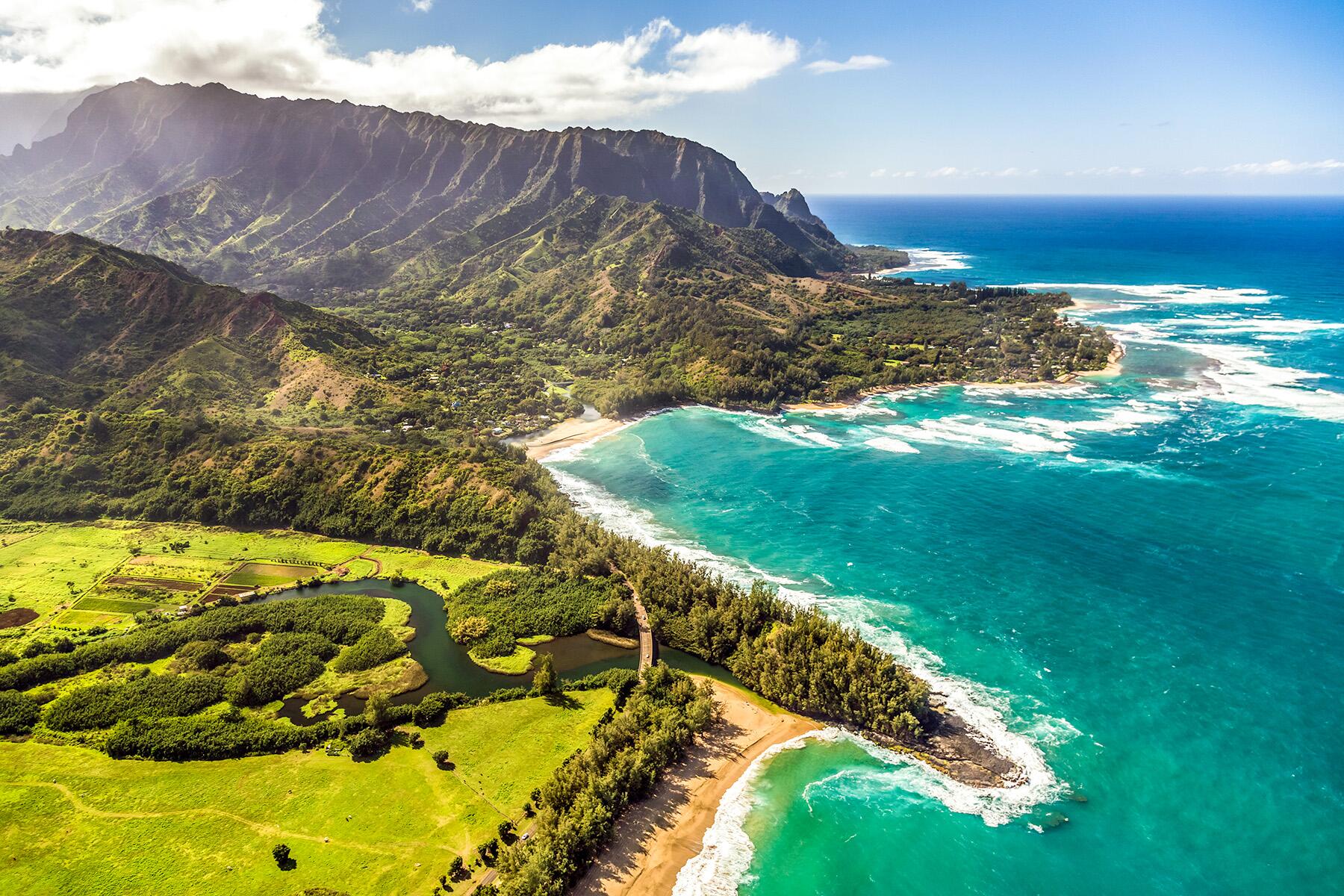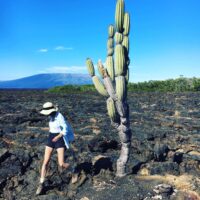Pack your bags—and your brains—for your trip to Kauai.
What is it about vacation that causes people to go from decent humans to tourists behaving badly? Perhaps the sun is to blame for all the fried brains, or maybe common sense goes out of office at the first sight of a mai tai. Whatever the reason, if you’re planning a trip to Kauai, please don’t be *that* tourist. Instead, follow these ten tips to be a respectful traveler in Kauai.
Learn About Kauai’s History and Current Events
Kauai is much more than a vacation destination. It’s home to a unique environment, Native Hawaiian culture, and modern-day challenges. Learning Kauai’s history will enrich your experience. Do a bit of pre-trip research—from the island’s physical formation about five million years ago to the arrival of Polynesians perhaps as early as 200 AD, to European contact beginning in the 1700s, the plantation era of the 1800s, and colonization and the suppression of Hawaiian culture in the 1900s—and arrive on Kauai with a better understanding of and appreciation for the landscapes, people, and culture you’ll encounter.
Pack Properly
Don’t put off packing ’til the last minute. Before you get swept up in daydreams of swaying palm trees and sunset cocktails by the beach, sit down and create a packing list specific to the activities on your itinerary. Of course, you’ll need the basics like your swimsuit and slippahs (sandals), but you should also consider items that help protect you and the environment, including reef-friendly sunscreen (if you forget yours, you can buy some in Kauai, but keep in mind that prices will likely be higher than at home) and a refillable water bottle so you can stay hydrated and avoid single-use plastic. Ask your hotel or tour operator well in advance about any gear you might need, such as a rash guard for a surf lesson or snorkeling tour, and whether or not they provide or rent gear.
Recommended Fodor’s Video
Practice Malama `aina
Hawaiian culture is deeply entwined with the environment. As a visitor enjoying Kauai’s beaches, hiking trails, and ocean, you share the kuleana (responsibility) to malama `aina (care for the land), and you have an opportunity to understand the local culture better and give back in a positive way.
Save some time in your schedule to participate in activities that foster a connection with residents and the natural elements. You can take a farm tour and learn about traditional techniques and staple crops like taro that are important to Hawaiian cuisine. Or volunteer during a community work day at a local fish pond, reforestation project, or beach cleanup. Some hotels, including Ko`a Kea Resort, even offer a discount or a free night when you participate in the Mālama Hawaiʻi program.
Support Local Businesses
Tourism dollars benefit the community when the money stays locally. Shop and book your tours and accommodations with businesses that support community initiatives and are locally-owned when possible. You can find fresh produce, food trucks, and artisan-made items at farmers’ markets and bring a taste of Kauai home to your loved ones with made-in-Kauai gifts, such as chocolate from Lydgate Farms. If you’ll be in Waimea, consider The West Inn, the only 100% locally owned and operated hotel on the island, or the Waimea Plantation Cottages—although they aren’t locally owned, they donate some of their profits to fund youth camps on Kauai.
INSIDER TIPAsk your hotel about artisan and farmers market events in the neighborhood and on the property. Some, including Timbers Kauai, bring the vendors to you with occasional on-site markets.
Say Yes to Native Hawaiian-Led Cultural Activities
Learn about Hawaiian culture from those who know it best. Seek out opportunities—such as hula workshops, lauhala weaving, lei-making, and ukulele lessons—to engage with Native Hawaiian cultural practitioners. Say yes to invitations to participate in ceremonies, celebrations, and festivals like the Kauai Mokihana Festival in September. Many hotels offer cultural activities to their guests, and you can also find hands-on classes at The Kauai Museum.
Be Mindful of Local Residents
Given the history of outsiders repressing and exploiting Hawaiian culture, it’s also important to understand that not everything is for you. While there are plenty of beaches, trails, and activities on Kauai that are accessible to visitors, the Hawaiian islands are home to sacred sites, including heiau (ceremonial and spiritual structures or sites), and some traditional practices that may be open only to Native Hawaiians and cultural practitioners.
Never pass through private property unless invited, and always respect residents’ advice and signage concerning sacred spots, ceremonies, and activities. Don’t take photos of people without their permission. If you’ll be surfing, it’s also wise to ask what breaks are best for visitors, and once you’re out on the water, you can hang back a bit at first and take note of local etiquette before entering the lineup.
Stay Humble and Informed
Kauai is not a theme park; while it is beautiful, it can also be dangerous if you’re not properly prepared. This is not the place to show off or push yourself beyond your physical limitations. Injuries can derail your trip and be costly, and tending to preventable visitor accidents can cause strain on local emergency response resources.
Always check age and skill level requirements for any adventures in nature, and bring (or rent) quality equipment. Obey ocean advisories as well as lifeguard warnings. Check the weather conditions before you set out on a hike—flash floods can impact trail conditions and even sweep you away if you’re in the wrong place at the wrong time.
Don’t Touch the Wildlife
You might feel drawn to the wildlife (I know, I know—turtles are cute!) and brightly colored plants you encounter on Kauai. But you should always keep a distance from wildlife and never touch things you find in nature (including rock stacks or cairns—they may be heiau). Doing so can disrupt the delicate ecosystem, cause stress for the animals, and put you in danger as well. And in some cases, disturbing protected areas, such as the Kuia Natural Area Reserve, and getting too close to Hawaiian monk seals, green sea turtles, and other endangered wildlife, is also illegal.
Use Only What You Need
Sustainability is central to Native Hawaiian culture and critical for preserving the natural resources on Kauai. Be mindful of your usage; turn off lights and air conditioners when not in your room (or forego the air conditioner and opt to open the windows and enjoy the ocean breeze instead), buy and use only what you need, recycle when possible, and consider donating any unused items and food when you leave.
Slow Down
Don’t expect things here to be the way they are where you live. Hawaii has its own style, and each island has its own personality. Leave your assumptions at home and instead open your mind to observe, ask questions, and listen to residents’ insight. Be patient and kind to the people you meet—many are working hard to provide memorable experiences for visitors like you. Make reservations for restaurants and tours in advance so you can avoid the disappointment (and meltdowns—remember, you’re not going to be *those* tourists!) of finding your top choices sold out. Always plan extra time for driving; weather conditions can cause delays, landslides, and other disruptions. Leave space in your schedule to experience Kauai’s magic—pausing to enjoy a rainbow, observing fluffy clouds floating over the ridges of Waimea Canyon, listening to the call of the Amakihi, or “talking story” with a new friend.







Mahalo Nui Loa for a great Artical. i hope people will follow this article.